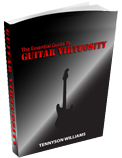Triadic Chord Structures - Part 2
Last time we were talking about Triadic chord structures. I showed you the Major triad formation and a Minor triad formation, and I had also promised to show you the next two. The Diminished and Augmented variations of those structures.
If you had played through the chord formations that I had given to you, you would had seen a common pattern, both in the Major triad structure and the Minor triad structure. Well, the good news is that the Diminished and Augmented versions of the chords are no different. What's the bad news? There is none! that's more good news.
As I had explained before, a triad is constructed from the major scale, by taking the 1st, 3rd and 5th notes of that scale and playing them together to sound the chord.
The last example was in G, but this time we're going to start in G# - the 4th fret on your low E string.
I'm going to go ahead and show you the Diminished and Augmented chords. They will run one octave like last time, spanning from G# to G#. Go ahead and play them through a few times and then when you're done, consult the Major scale at the bottom. Play it through a few times and then after that, consult the formulas for creating the Major, Minor, Diminished and Augmented triadic chords. Using the formula (which, is very straight forward) and the scale, see if you can't recreate these chords using a little detective work. I know you can do it! You may make a few mistakes at first, but after a little focusing, the notes will jump right out at you.
Click To Enlarge
Click To Enlarge
The G# Major scale
Click To Enlarge
The Formula Is:
Major triad contains (1 3 5) of a major scale.
Minor triad contains (1 b3 5) of a major scale.
Diminished triad contains (1 b3 b5) of a major scale.
Augmented triad contains (1 3 #5) of a major scale.
Note: Start with the G# Major triad chord. 4th fret on the low E string, 3rd fret on the A string and 1st fret on the D string. Come back to this chord if you get lost. Try to find these notes in the G# Major scale above. Once you feel like you understand how these notes structure this chord, start build the other chords off of this one. After you get the hang of it, try it else where. You can use the Major scale pattern anywhere, starting on the low E string.
May 12, 2008
Triadic Chord Structures part 2
Subscribe to:
Post Comments (Atom)


